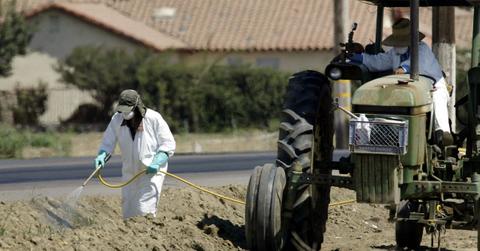EPA Bans Controversial Pesticide Chlorpyrifos From Being Sprayed on Food
Published Aug. 19 2021, 12:32 p.m. ET

In the U.S., it’s pretty typical for conventional produce to be grown with pesticides linked to various negative health effects on humans. However, this really shouldn’t be the norm — and fortunately, more and more toxic pesticides are slowly being phased out of the agricultural industry. Most recently, the EPA banned the pesticide chlorpyrifos.
Here’s everything you need to know about the ban, as well as how chlorpyrifos affects human health — especially children — and the environment.

The EPA banned the pesticide chlorpyrifos — here’s which food products may contain it.
On Wednesday, Aug. 18, the Environmental Protection Agency (EPA) announced that it is banning the use of chlorpyrifos on all food.
Chlorpyrifos is an insecticide used to grow a variety of row crops, including broccoli, cauliflower, fruit and nut trees, and soybeans. Additionally, when the Environmental Working Group (EWG) released the 2021 Dirty Dozen list earlier this year, the organization reported that chlorpyrifos was found on 10 percent of all basil, cilantro, frozen strawberries tested, hot peppers, and radishes tested.
The EPA plans to review the continued use of chlorpyrifos for its non-food applications.
Up until now, the EPA has had limits on how much chlorpyrifos could be used to grow crops; but as of this new ruling, the EPA is retracting all “tolerances” that have been granted regarding chlorpyrifos use on food crops.
The battle to ban chlorpyrifos has been going on for years. According to NPR, Trump’s EPA was considering making this same move, but the team claimed they did not find sufficient evidence of chlorpyrifos’ negative impacts on human health.
“Today EPA is taking an overdue step to protect public health. Ending the use of chlorpyrifos on food will help to ensure children, farmworkers, and all people are protected from the potentially dangerous consequences of this pesticide,” Michael S. Regan, EPA Administrator, said in a statement. “After the delays and denials of the prior administration, EPA will follow the science and put health and safety first.”
The EPA and EWG both recommend everyone eat plenty of fresh fruits and vegetables, regardless of organic status — just make sure to always thoroughly wash your produce, especially if it is conventional or on the Dirty Dozen list.
Chlorpyrifos is linked to health issues in children and farmers.
Chlorpyrifos was banned from indoor use in the U.S. in 2001 — which shows that the government has been well aware of the pesticide’s toxic effects for a while. Chlorpyrifos leads to neurotoxicity, and is linked to a number of negative health effects in both people and animals — primarily in children and farmers, as explained by the National Pesticide Information Center.
Children, who are exposed to chlorpyrifos when consuming produce treated with it, or if they live near crop fields, are more vulnerable to the effects of chlorpyrifos, as their bodies are still developing. The insecticide has been associated with developmental delays and disorders, ADD and ADHD, altered social behavior, and stunted brain development.
Farmers are typically exposed to large amounts of chlorpyrifos when they inhale the insecticide or absorb it through the eyes or the skin while applying it to crops. A 2016 study found that farmers in China who sprayed chlorpyrifos on the job are typically exposed to higher levels of the insecticide than recommended for any human, and that some even experienced potential oxidative damage.
Before chlorpyrifos was banned from being used indoors 20 years ago, a study found that pregnant people exposed to chlorpyrifos may give birth to babies with shorter birth length and lighter birth weight. Fortunately, those changes were not observed after 2001 — but pregnant people may still be more vulnerable to chlorpyrifos’ effects, as per the Pesticide Action Network.
The pesticide chlorpyrifos hurts the environment.
Chlorpyrifos is meant to kill insects — so it obviously presents a risk to wild insects and animals, including some endangered species. According to the Pesticide Action Network, chlorpyrifos can hurt or even kill small animals like amphibians, bees, birds, fish, reptiles, and some smaller mammals. The insecticide is also pretty persistent in the environment, and it can sometimes take years to break down in the soil.
What is chlorpyrifos’ trade name? The pesticide is sold under these brand names.
The U.S. government approved chlorpyrifos for use by the Dow Chemical Company in 1965. Up until February 2020, a company called Corteva produced chlorpyrifos under the popular trade names Lorsban and Dursban — but last year, Corteva announced that it would no longer produce chlorpyrifos production by 2021, according to Iowa State University.
And as per LSU AgCenter, two other common brand names for chlorpyrifos include Nufos and Warrior, the latter of which is an ear tag that farmers pierce through cattle’s ears to keep flies and ticks away — while exposing cows to chlorpyrifos' effects.